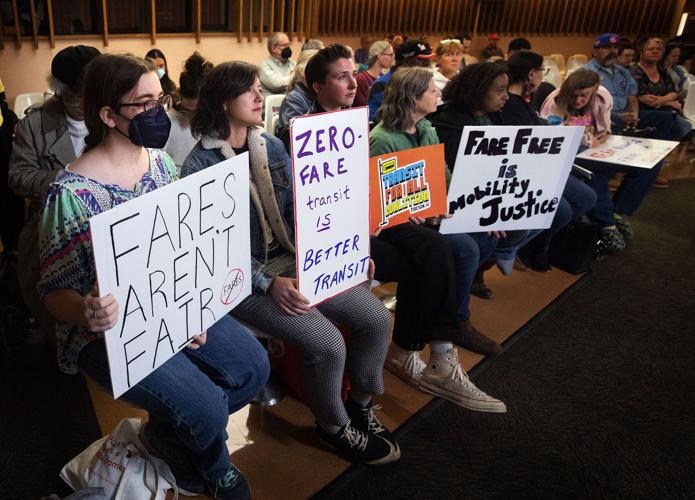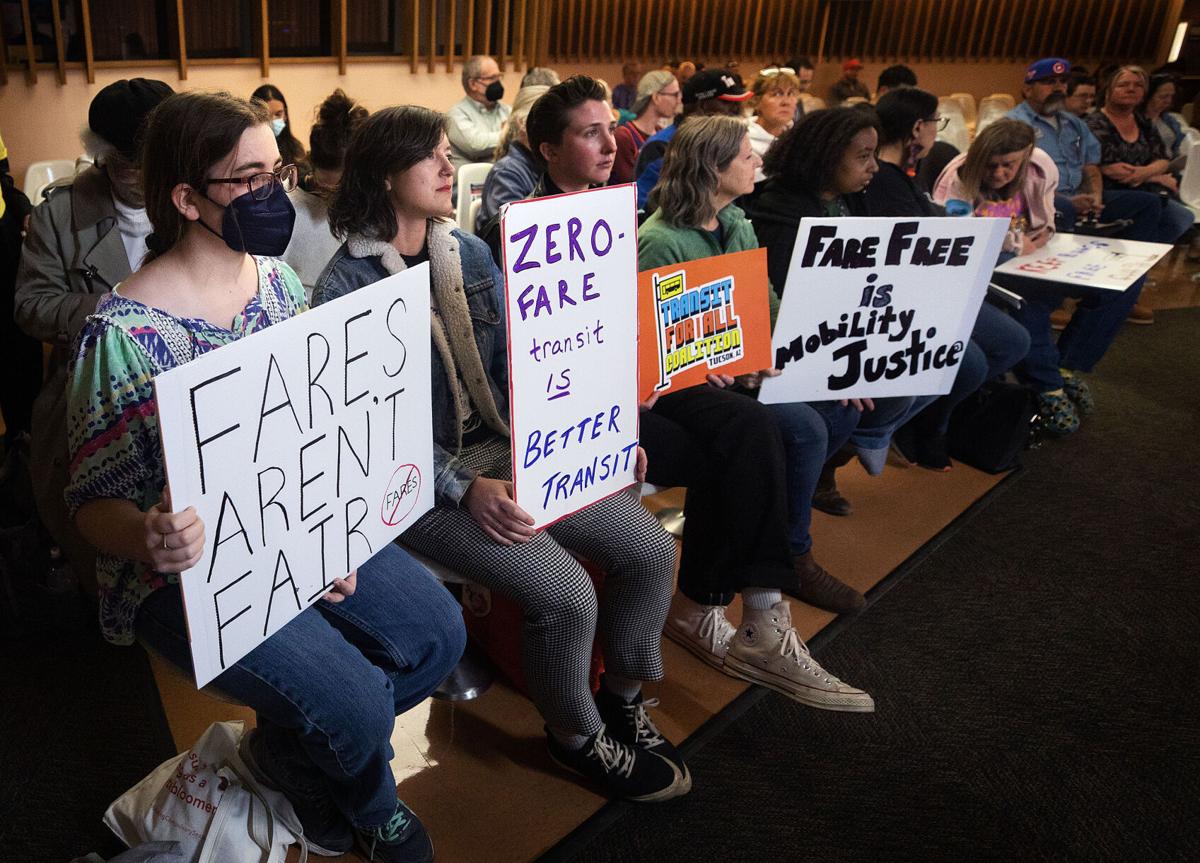As the federal funding Tucson has used to make local public transportation free for the last three years runs out, the city is assessing other ways to keep it that way ahead of a final decision on the matter scheduled to take place in less than three months.
For now, the city is gauging whether the region’s largest educational institutions are willing to help fund a fare-free transit system after taking a closer look at how many of their students and employees rely on it.
Access to the city’s public transportation network through Sun Tran, Sun Link and Sun Van has been free since City Council got rid of fares in March 2020 as a pandemic precaution. But the measure has also served as a test run for a permanently fare-free system, a concept many council members and public advocacy groups have expressed support for, while others contend it increases instances of crime and violence.
After delaying making a decision on keeping fares free four times, the council is set to come to a final decision on June 30.
According to the city, the total cost to operate Tucson’s public transit system was about $107 million last fiscal year. About $47 million in American Rescue Plan funds and $20 million of the city’s general fund covered the bulk of transportation costs, while the remainder came from federal grants, the Regional Transportation Authority and advertising revenue. Tucson estimates it’s lost $30 million in fare revenues in the past three years.
But as the COVID-19 relief funds dry up, paying for free public transportation would be a heavy lift for the city to take on its own. Instead, the city hopes other frequent users will provide funding for a fare-free system.
Potential partnerships
At its Tuesday meeting, City Council reviewed a report from Tucson’s Department of Transportation and Mobility outlining ridership data for students and employees at the University of Arizona, Pima Community College and Tucson Unified School District in the 2022-23 school year.
To find each entity’s ridership numbers, staff isolated bus stops in the immediate range of each location, looked at data from the Automated Passenger Counters that show the movement of riders through the transit system and considered bus stops in typical walking distances from campuses.
The results found the UA’s estimated bus ridership for the 2022-23 school year was more than 350,000, while 83% of riders on the Sun Link Streetcar were attributed to UA staff and students, with 1.4 million total rides.
Staff estimated PCC’s annual ridership was about 145,000 across its five campuses, including the West and Desert Vista locations that have on-campus bus stops. TUSD’s estimated ridership was nearly 407,000.
Mayor Regina Romero told the council she’s sent letters to heads of the UA, PCC and TUSD to “talk about the possibility of partnership.”

Passengers wait to enter the westbound streetcar at Main Gate Square.
The university “intends to continue partnering with the City of Tucson in support of city transit ridership for our faculty, staff, and students,” said Pam Scott, a UA spokesperson. She pointed out that the school already contributes about $800,000 a year to the transit system by paying 50% of the cost of transit passes for staff and students.
“We will continue conversations with leadership at the City of Tucson about our service fees, which we expect to be calculated based on the ridership of our faculty, staff and students,” Scott said in an email.
PCC Spokesperson Libby Howell said the community college has “only recently become aware of the City’s interest in receiving bus funding from PCC,” and it would be “premature to comment” without further information.
TUSD Superintendent Gabriel Trujillo presented a more optimistic tone and said in an email: “We know that transportation to and from school is a significant obstacle for thousands of young people across the district. We are excited at the prospect of working with our Governing Board, the Mayor and the city, to potentially remove this cost barrier for our students.”
Several other jurisdictions throughout the country work with partners to fund free fare systems, given the benefit they provide to the employees and students who use public transportation to get to and from work or school. City Manager Michael Ortega pointed to Chapel Hill, North Carolina, as an example of a transit system that shares the cost of free fares with its local university.
“There’s a true value to that organization, in terms of recruitment of students, recruitment of staff, so that they are then able to provide that fundamental service in a way that the transit conversation becomes an asset for them,” Ortega said.
The city plans to ask entities with access agreements, which are funding partnerships that provide discounted or free transit rates for employees or students, to instead put that money toward a city-wide free transit system.
In addition to UA’s annual $800,000 contribution for student and staff bus passes, PCC paid nearly $29,000 for bus passes the year before the city instated free fares, while TUSD paid about $889,000 for student bus passes, according to the transportation department’s report.
The report also outlined estimated ridership among the region’s largest employers using data from the Pima Association of Governments’ Travel Reduction Program report showing employee travel patterns. The top three transit users in 2022 were UA employees with an estimated 27,000 rides, Raytheon with about 22,000 rides, and Banner University Medical Center with about 18,000 rides.
“If I can identify for (regional employers) the value that comes to them and the potential of student recruitment and faculty recruitment, there’s value there that I can point to,” Ortega said.

A rider steps off a bus at the Ronstadt Transit Center in downtown Tucson.
More options
The transportation department’s report also lists other ways to fund free fares, including by raising parking prices, creating a tax for commercial parking transactions and increasing the city’s surcharge for nightly hotel and motel stays.
During Tuesday’s City Council discussion, Council Member Paul Cunningham pushed back against a hotel-motel surcharge as Tucson is “trying to bring tourism back” to pre-pandemic levels and expressed support for getting business buy-in to supplement lost fares.
Council Member Nikki Lee said she’d like to see other options, and “it’s very clear that $9 million for years to come is not there” to continue keeping fares free on the city’s dime alone. Council Member Dahl expressed support for free fares to enhance the city’s climate resiliency efforts.
Vice Mayor Steve Kozachik opposed increasing parking fees due to the business deterrent it could pose to local merchants and the fact that the money Park Tucson collects is currently targeted to pay off debt service.
Mayor Regina Romero emphasized that local buy-in is important because “public infrastructure leverages private investment,” pointing to the success of the metro area after the deployment of the Sun Link Streetcar.
“We’ve got to think about our transit system as a resource versus something that takes away from our budget,” she said.
Ortega said options to fund free fares will be part of ongoing budget discussions. Staff will likely refine potential funding options and provide more specifics at the council’s May 9 meeting. City Council is set to adopt a final budget for the next fiscal year on June 6.
Most Sun Tran passengers say they like the free fares that have been in existence since 2020, but some say it lets too many troublemakers on the buses.







